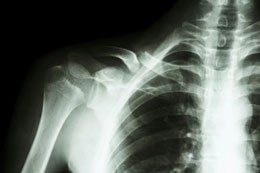The facts about the coracoid process* are dealt in this article. One should find the information presented below to be useful from the point of understanding the working and significance of this body part.

The coracoid process is a palpable (can be located by touch/feel) structure resembling a hook. It is positioned on the anterior-superior* part of scapula (shoulder blade). It is the lateral edge of the scapula where the coracoid bone can be found. This part of the skeletal system provides stability to the shoulder region. The Coracoid structure of the scapula extends forward laterally along with the acromion process. It is palpable just below the lateral end of the clavicle (collarbone), under the medial edge of the deltoid muscle.
Facts About the Coracoid Process
This part is connected with the scapula's neck (specifically the upper part of neck). A broad base of the coracoid process acts as a point of attachment with the scapula. The basic shape of this bone is curved and it is also thick. Direction in which the process runs is upwards at first and then medialward. As the coracoid becomes smaller, it changes direction. Finally, one can find it projecting forward and laterally. Muscles that attach to the coracoid include biceps brachii, pectoralis minor, and coracobrachialis muscle.
The structure of the coracoid bone can be understood in a better manner by studying its horizontal and ascending portions. The horizontal portion appears flattened if viewed from above. The surface of this portion is irregular and has a concave shape. Pectoralis minor is a muscle attached to this horizontal part. The ascending part of the coracoid process has a concave and smooth surface. The muscle called subscapuaris passes across the ascending part.
Coracoid Process Fracture
The fractures of the coracoid bone involve body parts such as the shoulder joint, scapula, and the tissues which surround the site of fracture. These tissues include the tendons, nerves, blood vessels, and ligaments. The causes of a coracoid fracture include direct injury or indirect stress. The underlying reasons for induction of stress include the contraction or twisting of one of the muscles attached to it. The experience of severe coracoid pain is one of the major symptoms of fracture. The site of injury, if touched, feels tender. Soft tissue around the fracture site also begins to swell.
Treatment
First aid measures to be taken for treatment of a coracoid fracture include the prevention of any kind of shock which could affect the injury/fracture site. As far as possible, the fractured area should not be moved. Surgery is conducted if the bone fragments have to be set properly from its displaced state. It is necessary to set the bones properly in place as early as possible. If the displaced bones are not put together in place within six hours of injury, they start losing elasticity. After this, it becomes difficult to bring these bones back to their normal position.
If the fracture/injury caused to the coracoid process is not very serious (did not cause displacement of muscles), the treatment needed is very simple to implement. A compression bandage needs to be used for keeping the site of injury immobilized. The compression bandage and sling should be placed on the fracture for 14 days. Increasing the circulation of blood at the site of this bone fracture is necessary for promoting the process of healing. Heating the area around the bone is recommended for increasing blood circulation. The different sources of heating which can be used for the purpose of fast recovery include hot baths, compresses, and showers; heating pads, heating lamps, liniments, heat ointments, etc.
*Process: It is an outgrowth of tissue from a larger body.
Anterior: Front.
Posterior: Back.
Superior: Top.
Inferior: Bottom.
Lateral: To the left or the right side away from the body(sideways).
Medial: Center


 The coracoid process is a palpable (can be located by touch/feel) structure resembling a hook. It is positioned on the anterior-superior* part of scapula (shoulder blade). It is the lateral edge of the scapula where the coracoid bone can be found. This part of the skeletal system provides stability to the shoulder region. The Coracoid structure of the scapula extends forward laterally along with the acromion process. It is palpable just below the lateral end of the clavicle (collarbone), under the medial edge of the deltoid muscle.
The coracoid process is a palpable (can be located by touch/feel) structure resembling a hook. It is positioned on the anterior-superior* part of scapula (shoulder blade). It is the lateral edge of the scapula where the coracoid bone can be found. This part of the skeletal system provides stability to the shoulder region. The Coracoid structure of the scapula extends forward laterally along with the acromion process. It is palpable just below the lateral end of the clavicle (collarbone), under the medial edge of the deltoid muscle.